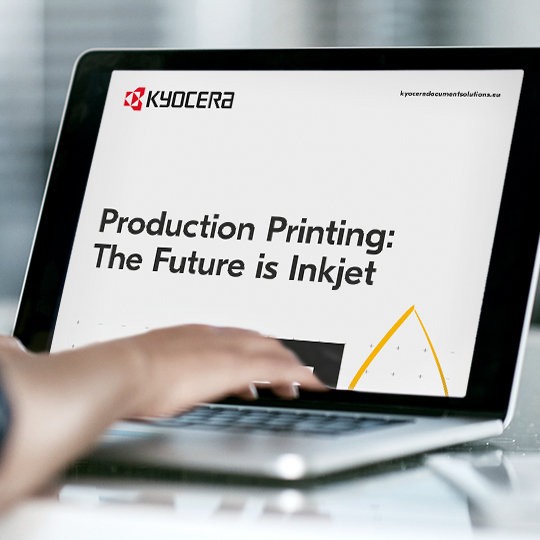Les entreprises du XXIe siècle sont plus conscientes que jamais de la nécessité d’être respectueuses de l’environnement, ce qui est particulièrement important lorsqu’il s’agit de travaux d’impression à grande échelle nécessitant des technologies comme l’impression de production.
La pression exercée sur les entreprises pour qu’elles respectent les réglementations environnementales est à son comble, alors qu’elles redoublent d’efforts pour atténuer les effets du changement climatique. Devenir plus écologique et durable est devenu une priorité croissante pour la majorité des entreprises.
L’impression à grande échelle étant l’un des plus grands consommateurs d’énergie et de ressources, il est essentiel de garder la planète à l’esprit. Selon un article d’Impress Print, l’industrie européenne de la pâte à papier, du papier et de l’impression est relativement énergivore, représentant environ 3,1 % de la consommation énergétique du continent.
Adopter une approche commerciale plus « verte » n’est pas seulement bénéfique pour l’environnement. Les entreprises ont également constaté que les consommateurs sont plus enclins à investir dans des produits et services lorsque le fournisseur propose des options plus respectueuses de l’environnement que la concurrence.La technologie choisie par une entreprise pour ses impressions joue un rôle clé dans son impact écologique.
La technologie d’impression jet d’encre numérique est un excellent exemple de méthode permettant de réduire la pollution environnementale.
Le jet d’encre permet aux entreprises d’imprimer de manière plus efficace et durable, ce qui a bien sûr un impact positif sur l’environnement, tout en leur permettant de réaliser des économies – une situation gagnant-gagnant pour toutes les parties impliquées.
Voici comment la technologie jet d’encre peut aider les entreprises à réduire leur impact environnemental :
La consommation d’énergie et la production de déchets peuvent être réduites au minimum
L’avenir est au jet d’encre
1. Réduction des déchets
Les appareils à jet d’encre utilisent des cartouches pour transférer une image numérique sur un support imprimé. En général, les imprimantes numériques sont la solution la plus intelligente pour les tirages de production de taille moyenne, souvent difficiles à réaliser à un coût raisonnable. L’impression de production permet de calculer et d’imprimer précisément la quantité nécessaire, sans surproduction ni gaspillage.
Plutôt que de surimprimer pour atteindre la quantité requise – et gaspiller ainsi des milliers d’exemplaires et l’énergie utilisée – ces appareils permettent d’imprimer exactement ce qui est nécessaire.
En plus des nombreuses initiatives de recyclage de cartouches promues par les entreprises utilisant le jet d’encre, des alternatives « vertes » font leur apparition sur le marché, avec des encres plus naturelles et écologiques, conçues pour être moins nocives pour l’environnement que les encres synthétiques.
2. Faible consommation d’énergie
Les imprimantes à jet d’encre consomment très peu d’électricité comparées à d’autres technologies numériques, comme les imprimantes laser. Ces dernières nécessitent beaucoup d’énergie pour chauffer le toner et maintenir des températures élevées tout au long du processus d’impression.
De plus, les imprimantes laser utilisent divers composants et consommables sophistiqués, ce qui augmente encore leur consommation énergétique. À l’inverse, les imprimantes à jet d’encre ne nécessitent que des cartouches.
Passer de la technologie laser au jet d’encre est donc très avantageux pour les entreprises soumises à des limites réglementaires de consommation d’énergie, car le jet d’encre reste bien en deçà de ces seuils.
3. Efficacité grâce à l’innovation
Un autre avantage important du jet d’encre est sa capacité à imprimer automatiquement de grandes quantités de documents personnalisés en un seul passage. Il n’est donc plus nécessaire d’utiliser deux appareils distincts (numérique et offset) pour préparer simultanément différents contenus personnalisés – une méthode encore utilisée par certaines entreprises. Bien que les imprimantes laser permettent aussi cela, elles le font à un coût bien plus élevé, ce qui les rend peu durables à long terme face à la montée du jet d’encre.
Les imprimantes à jet d’encre sont des appareils tout-en-un grâce à leurs capacités d’impression variable innovantes, ce qui permet de réduire au minimum la consommation d’énergie et la production de déchets.
Avec la demande croissante de contenus personnalisés – notamment dans le secteur du marketing – cette capacité est très attrayante pour les entreprises qui souhaitent continuer à produire de grands volumes tout en réduisant leur empreinte carbone et en affirmant leur engagement envers la protection de l’environnement.

Lisez l’eBook
Téléchargez un exemplaire et découvrez l’avenir de l’impression de production.

